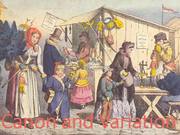Canon and Variation
Watched 1,160 times
Human validation
Video description
In music, a canon is a contrapuntal compositional technique or texture that employs a melody with one or more imitations of the melody played after a given duration (e.g., quarter rest, one measure, etc.). The initial melody is called the leader (or dux), while the imitative melody, which is played in a different voice, is called the follower (or comes). The follower must imitate the leader, either as an exact replication of its rhythms and intervals or some transformation thereof (see "Types of canon", below). Repeating canons in which all voices are musically identical are called rounds—"Row, Row, Row Your Boat" and "Frère Jacques" being widely known examples. An example of a classical strict canon is the Minuet of Haydn's String Quartet in D Minor, Op. 76, No. 2 (White 1976, 66).
Category:
Top Free Online Videos tagged Music
Added on
18 May 2016
Comments
Your account has no avatar
To proceed with comment posting, please select temporary avatar:
Confirm
Something went wrong, please try again.
Or
Upload on Y8 Account
Cancel



















